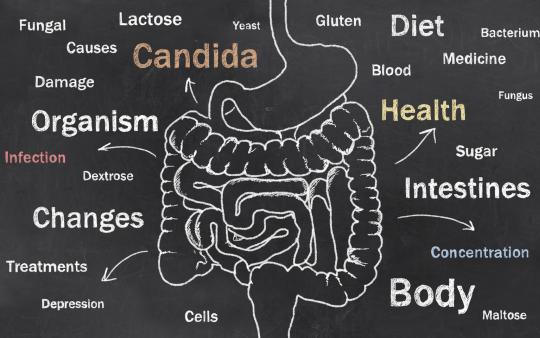Yeast is a kind of fungus and is one of the many microbes that live on every inch of our bodies. The most common type is called Candida, which likes to live in moist places like the mouth, vagina, and on the skin. Some Candida microbes are normal and part of our body’s undetectable ecology, but when the environment is right, it can get out of control quickly. This overgrowth becomes a yeast infection called candidiasis, often simply referred to as “candida.”
Why me?
All bodies can be affected by a Candida overgrowth. Babies can get diaper rash, a form of a yeast infection. Candida can escape these warm and moist places down below and take up residence in higher-up ones. Thrush is an overgrowth of Candida in the mouth and is very common in babies and kids. It looks like creamy white fur on the tongue.
Many health professionals are not aware that candida can be more than a topical issue. It can also move into the brain, joints, and all through the digestive tract. It can even present in unexpected ways such as brain fog, anxiety, sinus problems, infertility, and any sort of gut complaint. There are specialized tests to detect Candida, but these often produce false negatives. A comprehensive checklist of candidiasis symptoms may be more helpful in determining if Candida is the culprit.
And women are all too familiar with the curse of vaginal yeast infections, characterized typically by itching, burning, odor and sometimes cream-coloured discharge. But what sets these yeast beasties off?
Estrogen and other hormones that proliferate in pregnancy are particularly favourable to candida. Just before menstruation is also a prime time for a yeast overgrowth, as the extra fluids create the moist setting that yeast loves. Stress, poor sleep, and certain food choices can weaken the immune system to set up a nice home for it. A weakened immune system most assuredly promotes candida woes, in particular if the person often takes antibiotics, antivirals, or steroids to treat other health concerns. Taking antibiotics especially can just about guarantee a need to treat for a yeast infection too, and many doctors automatically prescribe candida medication in conjunction with antibiotics. Why? Yeast is normally kept in check by an acidic “good guy” bacteria such as Lactobacillus. Because antibiotics destroy both the good and the bad guys in the digestive system, the bad guys get a chance to multiply faster than the good guys, and yeast starts to take over the neighbourhood.
A naturopathic approach
Most yeast infections can be treated simply with over-the-counter ointments, suppositories, or mouthwashes. In more severe cases, pharmaceutical antifungals like nystatin (Mycostatin) or fluconazole (Diflucan) are prescribed.
Some cases can be very stubborn to treat if they’re chronic, and treatment follows a discouraging cycle of futility. Does this sound familiar? For instance, many women seek the care of their OB/GYN for vaginal yeast infections and repeatedly try suppositories, which often don’t work or can even make it worse. So after a few rounds of frustration, a pill is prescribed. Now the woman has to monitor her liver function just to control a yeast overgrowth. Then, the pill often either stops working or never worked at all. Even more alarming, a recent study found a link between the pharmaceutical fluconazole and an increased risk of miscarriages.
Suppositories and antifungals kill the weak microbes but do nothing to prevent future infections. When yeast feels threatened, it doesn’t want to give up its happy home and will secrete something called a biofilm. This is a slimy sticky coating the yeast puts around itself as it balls up into a spore and becomes dormant. These spores can hang out in the gut for a long time and then when the person goes back to normal food choices and conditions, the spores pop back into action and guess what? Right back to square one with symptoms and, yes, the hamster wheel of treatment. So now what?
A naturopathic approach is a better way to rid the body of a Candida, or any yeast/fungal overgrowth, but you will need tenacity and support to get through it! The key is to stop feeding it and crowd it out with good organisms to kill it off. This is a program that requires at least thirty days of a very restrictive diet enhanced by supplements. There are no “cheat days” with this plan and you need to set yourself up for best success. Look at the month ahead and be sure there is nothing that will conflict with the candida program. Wait for vacation to be over and don’t start this over the holidays. Have all members of your family on board with your plan: Your partner cannot be munching your favorite candy as you watch TV together, nor should your mom try to convince you that one bite of cake will be okay! Those who travel for work will need to plan accordingly and may even need to bring food with them.
Eating for “unyeasting”
The diet looks very “paleo” or even “keto”: There is a need to limit sugar and carbs. There are also restrictions on what kinds of veggies can be eaten, like high carb potatoes, corn, and beets. Fruit must be avoided for a few weeks, and dried fruit and melons must be eliminated the entire time. Labels need to be closely read because, for example, there is a need to avoid vinegar, which many prepared condiments and dressings contain, and hidden sources of sugar may only be discovered by scrutinizing ingredients. There is also no alcohol, especially beer and wine (I know, you could have used that to get through this! Sorry!). Good quality (grass-fed, pasture-raised) meat and most veggies are just fine for a candida program. Vegetarians need to think a bit harder for treating candida as their normal food choices tend to be high in carbs, and as a result it can take longer for them to experience lasting relief from candida. Busy parents also must decide if the entire family will embrace these food choices for a few weeks or if they will cook separate meals for the kids (and/or the unafflicted partner!). Going out to eat can be very challenging. Some will need to eat at their desk to avoid unhealthy temptations at lunch with coworkers.
Though maybe a happy side effect for a few, most people will lose weight on a candida program and that is a consideration for those battling anorexia/bulimia, or for those recovering from a tough chronic disease like cancer or a physical trauma requiring long downtime. For these people, they need all the calories they can get to fully heal and waiting to treat candida this way is better left for a future endeavor. A candida cleanse is not advisable in pregnancy and when breastfeeding.
Yeast-busting supplements
In addition to a basic multivitamin and other daily nutrient support for optimal health, there is a need for a high-quality probiotic. The probiotic will be taken with food a few times a day and will help crowd out the yeast and support repopulation of the gut with good guys. In addition, an antifungal supplement is employed to target the yeast itself.
There are many antifungal supplements out there with undecylic or caprylic acid in them and usually a blend of herbs — often wormwood, oregano, and garlic — known to kick candida out of the body. These are taken between meals along with a “biofilm buster” to break open the yeast and prevent spore formation. This is typically done using a digestive enzyme or n-acteyl-cystein (NAC).
Easing the aggravation
Treatment is an inextricable collaboration of elements. The antifungal herbs and acid won’t work unless the biofilm is broken. Those supplements won’t work without the dietary changes. And it all needs at least one month of dedicated discipline for lasting relief, but most feel much better within one week. In the meantime, there are some measures you can take to provide temporary relief of vaginal irritation:
- Commercially produced natural suppositories and creams
- Coconut oil
- Oatmeal or Epsom salt baths
- Using the hottest water you can tolerate from a hand held shower head and lots of soapy water
- Boric acid capsules (found on the internet or made at home) or garlic inserted vaginally as a suppository. Do not use boric acid if you are pregnant.
Treatment for candida can feel overwhelming for some. To best support the body and to make sure candidiasis stays at bay, and even when not treating candida, it is wise to optimize the entire body with healthy food choices, adequate hydration, and rest. Chronic stress makes it even harder to treat by weakening both the digestive and immune system, so stress management needs to be part of the equation for creating a candida protocol.
This plan is doable and does work — honest! Patience is important, but think about it: less is required for this short-term method than for suffering through an endless series of unsuccessful treatments. Finally be free of the aggravation of chronic yeast overgrowths. Consider consulting with your naturopathic doctor to help you be rid of candida forever with an effective and lasting plan.






